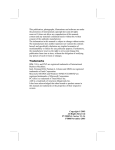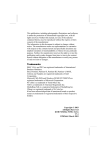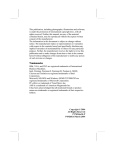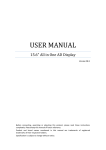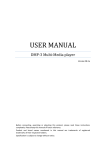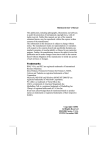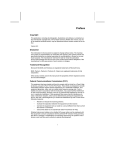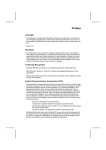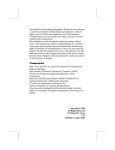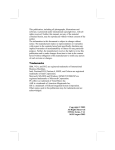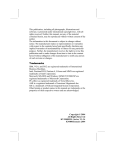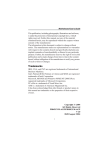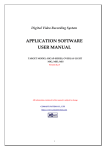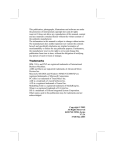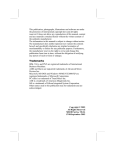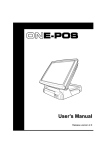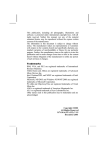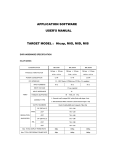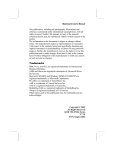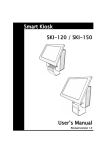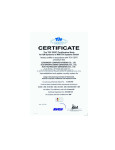Download Trademarks
Transcript
This publication, photographs, illustrations and software are under the protection of international copyright laws and all rights reserved. It does not allow any reproduction of this manual, content and any materials contained herein without the written consent of the authentic manufacturer. The information in this manual is subject to change without notice. The manufacturer does neither represent nor warrant the contents hereof; and specifically disclaims any implied warranties of merchantability or fitness for any particular purpose. Furthermore, the manufacturer reserves the right to revise and change this publication from time to time, without the obligation of notifying any person of such revision or changes. Trademarks IBM, VGA, and PS/2 are registered trademarks of International Business Machines. Intel, Pentium/II/III, Pentium 4, Celeron and MMX are registered trademarks of Intel Corporation. Microsoft, MS-DOS and Windows 98/ME/NT/2000/XP are registered trademarks of Microsoft Corporation. PC-cillin is a trademark of Trend Micro Inc. AMI is a trademark of American Megatrends Inc. It has been acknowledged that other brands or product names in this manual are trademarks or the properties of their respective owners. Copyright © 2004 All Rights Reserved PVT800X-P Series PT800/March 2004 Table of Contents Trademark ..................................................................................... I Static Electricity Precautions.................................................III Pre-Installation Inspection.....................................................III Chapter 1: Introduction................................................................1 Key Features .............................................................................2 Package Contents......................................................................6 Chapter 2: Motherboard Installation ..........................................7 Motherboard Components ........................................................8 I/O Ports....................................................................................8 Installing the Processor.............................................................9 Installing Memory Modules ...................................................10 Jumper Settings.......................................................................11 Install The Motherboard .........................................................12 Connecting Optional Devices .................................................13 Install Other Devices ..............................................................15 Expansion Slots .....................................................................18 Chapter 3: BIOS Setup Utility ...................................................19 Introduction ............................................................................19 Running the Setup Utility ............ …………………………...20 Standard CMOS Setup Page...................................................21 Advanced Setup Page .............................................................22 Power Management Setup Page .............................................25 PCI/Plug and Play Setup Page................................................26 Load Optimal Settings ............................................................27 Load Best Performance Settings.............................................27 Features Setup Page................................................................27 CPU PnP Setup Page ..............................................................29 Hardware Monitor Page..........................................................30 Change Password....................................................................30 Exit. .......................................................................................30 Chapter 4: Software & Applications .........................................31 Introduction ............................................................................31 Installing Support Software ....................................................32 Bundled Software Installation ................................................34 Hyper-Threading CPU............................................................35 II Static Electricity Precautions Static electricity could damage components on this motherboard. Take the following precautions while unpacking this motherboard and installing it in a system. 1. Don’t take this motherboard and components out of their original static-proof package until you are ready to install them. 2. While installing, please wear a grounded wrist strap if possible. If you don’t have a wrist strap, discharge static electricity by touching the bare metal of the system chassis. 3. Carefully hold this motherboard by its edges. Do not touch those components unless it is absolutely necessary. Put this motherboard on the top of a static-protection package with component side facing up while installing. Pre-Installation Inspection 1. Inspect this motherboard whether there are any damages to components and connectors on the board. 2. If you suspect this motherboard has been damaged, do not connect power to the system. Contact your motherboard vendor about those damages. III Notice: 1.Owing to Microsoft’s certifying schedule is various to every supplier, we might have some drivers not certified yet by Microsoft. Therefore, it might happen under Windows XP that a dialogue box (shown as below) pops out warning you this software has not passed Windows Logo testing to verify its compatibility with Windows XP. Please rest assured that our RD department has already tested and verified these drivers. Click the “Continue Anyway” button and go ahead the installation. 2. USB 2.0 Driver Limitations: 2-1.The USB 2.0 driver only supports Windows XP and Windows 2000. 2-2.If you connect a USB 2.0 hub to the root hub, plugging USB devices into this hub, the system might not successfully execute certain USB devices’ connection because it could not recognize these devices. IV Chapter 1 Introduction This motherboard has a Socket-478 to support Intel Prescott / Pentium 4 with Hyper-Threading Technology processors with Front-Side Bus (FSB) speeds up to 800/533 MHz. The Prescott CPU provides higher power, better voltage regulator tolerance and thermal solution, performing better graphics and audio, speeding up the processor. Hyper-Threading Technology, designed to take advantage of the multitasking features in Windows XP, gives you the power to do more things at once. It integrates the VIA PT800 Northbridge along with VT8237 Southbridge chipsets that supports the Serial ATA — a new interface for high-performance and mainstream desktop PCs; the built-in USB 2.0 providing higher bandwidth, implementing Universal Serial Bus Specification Revision 2.0 and is compliant with UHCI 1.1 and EHCI 1.0. It supports AC’97 Audio Codec and provides Ultra DMA 33/66/100/133 function. It has one 8x AGP, one CNR (Communications and Networking Riser) and four 32-bit PCI slots. There is a full set of I/O ports including two PS/2 ports for mouse and keyboard, one serial port, one parallel port, one LAN port (optional), four back-panel USB2.0 ports and onboard USB connectors USB3/USB2 providing four extra ports by connecting the Extended USB Module to the motherboard. This motherboard is a Full ATX motherboard and has power connectors for an ATX power supply. Note: You must initiate the HT CPU function through BIOS setup. It is strongly recommended you refer to Page 35 for relative details. Key Features This motherboard has these key features: Socket-478 Processor ♦ Supports Intel Prescott / Pentium 4 series CPU with Hyper-Threading Technology ♦ Supports up to 800/533 MHz Front-Side Bus Hyper-Threading technology enables the operating system into thinking it’s hooked up to two processors, allowing two threads to be run in parallel, both on separate ‘logical’ processors within the same physical processor. Chipset There are VIA PT800 Northbridge and VIA 8237 Southbridge in the chipsets in accordance with an innovative and scalable architecture with proven reliability and performance. Here is a list of the chipset arrangement and their respective features: NB SB Function CPU FSB: 800/533MHz PT800 8237 DDR400, maximum eight USB2.0 ports, two Serial ATA connectors ♦ Defines Highly Integrated Solutions for Performance PC Desktop Designs--High performance Northbridge with 800/533 MHz Front Side Bus for Pentium 4 plus AGP 8x external bus. ♦ Provide superior performance between the CPU, DRAM, V-Link bus and AGP8X graphics controller bus with pipelined, burst, and concurrent operation. ♦ Full Featured Accelerated Graphics Port (AGP) Controller --AGP v3.0 compliant with 8x transfer mode. ♦ Advanced High-Performance DDR DRAM Controller -Supports DDR400, DDR333, DDR266, and DDR200 double-data-rate synchronous DRAM. 2 ♦ High Bandwidth 533 MB/ sec 8-bit V-Link Host Controller --Configurable outstanding transaction queue for Host to V-Link Client accesses. ♦ Advanced System Power Management Support – ACPI 1.0B and PCI Bus Power Management 1.1 compliant. ♦ PCI to system memory data streaming up to 132Mbyte/sec (data sent to north bridge via high speed V-Link interface) ♦ PCI-2.2 compliant, 32-bit 3.3V PCI interface with 5V tolerant inputs ♦ Support up to six PCI master and decoding for all integrated functions and LPC bus. ♦ Dual Channel Serial ATA/RAID Controller—Complies with Serial ATA Specification Revision 1.0 Memory Support ♦ Two 184-pin DIMM sockets for DDR SDRAM memory modules ♦ Supports DDR400/333 memory bus ♦ Maximum installed memory is 2GB AC’97 Audio Codec 6- channel and compliant with Intel AC’97 (REV. 2.3) Spec, meeting with Microsoft PC2001 requirements Advanced power management and power saving capabilities. Stereo Line-in function shared with Surround out. High quality pseudo-differential analog CD Audio input. S/PDIF Input support: S/PDIF In is featured with interrupt, auto-lock, anti-noise, and anti-distortion functionalities support. Valuable add-on software technology: Support most industry standards of PC 3D sound and unique karaoke function support featured with microphone echo, key shifting, and vocal cancellation. 3 Expansion Options The motherboard comes with the following expansion options: ♦ Four 32-bit PCI slots ♦ One 8x/4xAGP slot ♦ One Communications Network Riser (CNR) slot Onboard IDE ♦ Two IDE Connectors ♦ Supports PIO (Programmable Input/Output) and DMA (Direct Memory Access) modes ♦ Supports IDE Ultra DMA bus mastering with transfer rates of 33/66/100/133 MB/sec Serial ATA ♦ Two Serial ATA Connectors ♦ Transfer rate exceeding best ATA (~150 MB/s) with scalability to higher rates ♦ Low pin count for both host and devices Onboard I/O Ports The motherboard has a full set of I/O ports and connectors: ♦ Two PS/2 ports for mouse and keyboard ♦ One serial port ♦ One parallel port ♦ Four back-panel USB2.0 ports ♦ One LAN port (optional) ♦ Audio jacks for microphone, line-in and line-out Fast Ethernet LAN (optional) ♦ 100Base-TX/10Base-T Physical Layer Solution ♦ Dual Speed – 100/10 Mbps ♦ MII Interface to Ethernet Controller/Configuration & Status ♦ Auto Negotiation: 10/100, Full/Half Duplex 4 ♦ Meet All Applicable IEEE802.3, 10Base-T and 100BaseTX Standards USB 2.0 ♦ Compliant with Universal Serial Bus Specification Revision 2.0 ♦ Compliant with Intel’s Enhanced Host Controller Interface Specification Revision 1.0 ♦ Compliant with Universal Host Controller Interface Specification Revision 1.1 ♦ PCI multi-function device consists of two UHCI Host Controller cores for full-/low-speed signaling and one EHCI Host Controller core for high-speed signaling ♦ Root hub consists 4 downstream facing ports with integrated physical layer transceivers shared by UHCI and EHCI Host Controller ♦ Support PCI-Bus Power Management Interface Specification release 1.1 ♦ Legacy support for all downstream facing ports BIOS Firmware This motherboard uses AMI BIOS that enables users to configure many system features including the following: ♦ Power management ♦ Wake-up alarms ♦ CPU parameters and memory timing ♦ CPU and memory timing The firmware can also be used to set parameters for different processor clock speeds. Bundled Software ♦ PC-Cillin provides automatic virus protection under Windows 98/ME/NT/2000/XP ♦ Adobe Acrobat Reader is the software to help users read .PDF files. Dimensions ♦ Full ATX form factor of 305 x 190mm 5 Note: Hardware specifications and software items are subject to change without notification. Package Contents Your motherboard package contains the following items: The motherboard The User’s Manual One diskette drive ribbon cable (optional) One IDE drive ribbon cable The Software support CD Optional Accessories You can purchase the following optional accessories for this motherboard. The Extended USB module The CNR v.90 56K Fax/Modem card The Card Reader The Serial ATA cable (optional) Note: You can purchase your own optional accessories from the third party, but please contact your local vendor on any issues of the specification and compatibility. 6 Chapter 2 Motherboard Installation To install this motherboard in a system, please follow these instructions in this chapter: Identify the motherboard components Install a CPU Install one or more system memory modules Make sure all jumpers and switches are set correctly Install this motherboard in a system chassis (case) Connect any extension brackets or cables to connectors on the motherboard Install peripheral devices and make the appropriate connections to connectors on the motherboard Note: 1. Before installing this motherboard, make sure jumper JBAT1 is under Normal setting. See this chapter for information about locating JBAT1 and the setting options. 2. Never connect power to the system during installation; otherwise, it may damage the motherboard. 7 Motherboard Components Identify major components on the motherboard via this diagram underneath. I/O Ports The illustration below shows a side view of the built-in I/O ports on the motherboard. (optional) (shared with JP1) 8 PS/2 Mouse PS/2 Keyboard Parallel Port (PRN) COM1 LAN Port (optional) USB Ports Use the upper PS/2 port to connect a PS/2 pointing device. Use the lower PS/2 port to connect a PS/2 keyboard. Use the Parallel port to connect printers or other parallel communications devices. Use the COM port to connect serial devices such as mice or fax/modems. COM1 is identified by the system as COM1. Connect an RJ-45 jack to the LAN port to connect your computer to the Network. Use the USB ports to connect USB devices. Note: The lower USB port located near the Parallel port is shared with the JP1 connector. Audio Ports Use the three audio ports to connect audio devices. The first jack is for stereo Line-In signal. The second jack is for stereo LineOut signal. The third jack is for Microphone. Installing the Processor This motherboard has a Socket 478 processor socket. When choosing a processor, consider the performance requirements of the system. Performance is based on the processor design, the clock speed and system bus frequency of the processor, and the quantity of internal cache memory and external cache memory. CPU Installation Procedure Follow these instructions to install the CPU: 1 CPU_FAN1 Pin 1 SOCKET-478 1. Unhook the locking lever of the CPU socket. Pull the locking lever away from the socket and raising it to the upright position. 9 2. Match the pin1 corner marked as the beveled edge on the CPU with the pin1 corner on the socket. Insert the CPU into the socket. Do not use force. 3. Push the locking lever down and hook it under the latch on the edge of socket. 4. Apply thermal grease to the top of the CPU. 5. Install the cooling fan/heatsink unit onto the CPU, and secure them all onto the socket base. 6. Plug the CPU fan power cable into the CPU fan connector (CPU_FAN1) on the motherboard. Installing Memory Modules This motherboard accommodates two 184-pin 2.5V DIMM sockets (Dual Inline Memory Module) for unbuffered DDR400 / 333 memory modules (Double Data Rate SDRAM), and maximum 2.0 GB installed memory. DDR SDRAM is a type of SDRAM that supports data transfers on both edges of each clock cycle (the rising and falling edges), effectively doubling the memory chip’s data throughput. DDR DIMMs can synchronously work with 266/333/400 MHz memory bus. DDR SDRAM provides 1.6 GB/s, 2.1 GB/s, 2.7 GB/s or 3.2 GB/s data transfer rate when the bus is 100 MHz, 133 MHz, 166 MHz or 200 MHz, respectively. DIMM1 DIMM2 10 Memory Module Installation Procedure These modules can be installed with up to 2 GB system memory. Refer to the following to install the memory module. 1. Push down the latches on both sides of the DIMM socket. 2. Align the memory module with the socket. There is a notch on the DIMM socket that you can install the DIMM module in the correct direction. Match the cutout on the DIMM module with the notch on the DIMM socket. 3. Install the DIMM module into the socket and press it firmly down until it is seated correctly. The socket latches are levered upwards and latch on to the edges of the DIMM. 4. Install any remaining DIMM modules. Jumper Settings Connecting two pins with a jumper cap is SHORT; removing a jumper cap from these pins, OPEN. 1 JP2 JP3 1 1 JBAT1 JBAT1: Clear CMOS Jumper Use this jumper to clear the contents of the CMOS memory. You may need to clear the CMOS memory if the settings in the Setup Utility are incorrect and prevent your motherboard from operating. To clear the CMOS memory, disconnect all the power cables from the motherboard and then move the jumper cap into the CLEAR setting for a few seconds. Function Normal Clear CMOS Jumper Setting Short Pins 1-2 Short Pins 2-3 11 JP2, JP3: CPU Clock Use this jumper to enable the selection of the CPU frequency. CPU Clock 100M 133M 200M JP2 Short Pins 2-3 Short Pins 1-2 Short Pins 2-3 JP3 Short Pins 2-3 Short Pins 2-3 Short Pins 1-2 Install the Motherboard Install the motherboard in a system chassis (case). The board is an ATX size motherboard. You can install this motherboard in an ATX case. Make sure your case has an I/O cover plate matching the ports on this motherboard. Install the motherboard in a case. Follow the case manufacturer’s instructions to use the hardware and internal mounting points on the chassis. 1 1 PJ1 SYSTEM_FAN1 1 CN2 PANEL2 Connect the power connector from the power supply to the CN2 connector on the motherboard. The PJ1 is a +12V connector for CPU Vcore power. If there is a cooling fan installed in the system chassis, connect the cable from the cooling fan to the SYSTEM_FAN1 fan power connector on the motherboard. Connect the case switches and indicator LEDs to the PANEL2 connector. Here is a list of the PANEL2 pin assignments. Pin 1 3 5 7 9 Signal HD_LED_P(+) HD_LED_N(-) RESET_SW_N(-) RESET_SW_P(+) RSVD_DNU Pin 2 4 6 8 10 12 Signal FP PWR/SLP(+) FP PWR/SLP(-) POWER_SW_P(+) POWER_SW_N(-) KEY Connecting Optional Devices Refer to the following for information on connecting the motherboard’s optional devices: 1 1 SPK1 JP1 1 1 PANEL1 USB2 1 1 SIR1 USB3 SPK1: Speaker Connector Connect the cable from the PC speaker to the SPK1 connector on the motherboard. Pin 1 3 Signal SPKR GND Pin 2 4 Signal NC +5V PANEL1: Front Panel Audio Connector This connector allows the user to install auxiliary front-oriented microphone and line-out ports for easier access. Pin 1 3 5 7 9 Signal AUD_MIC AUD_MIC_BIAS AUD_FPOUT_R HP_ON AUD_FPOUT_L Pin 2 4 6 8 10 Signal AUD_GND AUD_VCC AUD_RET_R KEY AUD_RET_L USB2/USB3: Front panel USB Connector The motherboard has USB ports installed on the rear edge I/O port array. Additionally, some computer cases have USB ports at the front of the case. If you have this kind of case, use auxiliary USB connectors USB2/USB3 to connect the front-mounted ports to the motherboard. 13 Pin 1 3 5 7 9 Signal VERG_FP_USBPWR0 USB_FP_P0USB_FP_P0+ GROUND KEY Pin 2 4 6 8 10 Signal VERG_FP_USBPWR0 USB_FP_P1USB_FP_P1+ GROUND USB_FP_OC0 1. Locate the USB2/3 connector on the motherboard. 2. Plug the bracket cable onto the USB2/3 connector. 3. Remove a slot cover from one of the expansion slots on the system chassis. Install an extension bracket in the opening. Secure the extension bracket to the chassis with a screw. JP1: USB Card Reader Connector (optional) This connector is for connecting internal USB card reader. You can use a card reader to read or transfer files and digital images to your computer. Pin 1 3 5 Signal VCC5 USB+ KEY Pin 2 4 Signal USBGND The JP1 is shared with one of the USB ports of the I/O back panel. The USB port is located near the Parallel port connector. See “I/O Ports” for more information. Please check the pin assignment of the cable and the USB header on the motherboard. Make sure the pin assignment will match before plugging in. Any incorrect usage may cause unexpected damage to the system. The vendor won’t be responsible for any incidental or consequential damage arising from the usage or misusage of the purchased product. 14 SIR1: Infrared Port The infrared port allows the wireless exchange of information between your computer and similarly equipped devices such as printers, laptops, Personal Digital Assistants (PDAs), and other computers. Pin 1 3 5 Signal NC +5V IRTX Pin 2 4 6 Signal KEY GND IRRX 1. Locate the infrared port SIR1 connector on the motherboard. 2. If you are adding an infrared port, connect the ribbon cable from the port to the SIR1 connector and then secure the port to an appropriate place in your system chassis. Install Other Devices Install and connect any other devices in the system following the steps below. 1 1 1 FDC1 IDE2 IDE1 CN4 CN3 Floppy Disk Drive The motherboard ships with a floppy disk drive cable that can support one or two drives. Drives can be 3.5” or 5.25” wide, with capacities of 360K, 720K, 1.2MB, 1.44MB, or 2.88MB. Install your drives and connect power from the system power supply. Use the cable provided to connect the drives to the floppy disk drive connector FDC1. 15 IDE Devices IDE devices include hard disk drives, high-density diskette drives, and CD-ROM or DVD-ROM drives, among others. The motherboard ships with an IDE cable that can support one or two IDE devices. If you connect two devices to a single cable, you must configure one of the drives as Master and one of the drives as Slave. The documentation of the IDE device will tell you how to configure the device as a Master or Slave device. The Master device connects to the end of the cable. Install the device(s) and connect power from the system power supply. Use the cable provided to connect the device(s) to the Primary IDE channel connector IDE1 on the motherboard. If you want to install more IDE devices, you can purchase a second IDE cable and connect one or two devices to the Secondary IDE channel connector IDE2 on the motherboard. If you have two devices on the cable, one must be Master and one must be Slave. Serial ATA Devices The Serial ATA (Advanced Technology Attachment) is the standard interface for the IDE hard drives, which is designed to overcome the design limitations while enabling the storage interface to scale with the growing media rate demands of PC platforms. It provides you a faster transfer rate of 150 MB/s. If you have installed a Serial ATA hard drive, you can connect the Serial ATA cables to the Serial ATA hard drive or the connecter on the motherboard. On the motherboard, locate the Serial ATA connectors CN3/CN4, which support new Serial ATA devices for the highest data transfer rates, simpler disk drive cabling and easier PC assembly. It eliminates limitations of the current Parallel ATA interface, but maintains register compatibility and software compatibility with Parallel ATA. 16 Internal Sound Connections If you have installed a CD-ROM drive or DVD-ROM drive, you can connect the drive audio cable to the onboard sound system. 1 CD2 When you first start up your system, the BIOS should automatically detect your CD-ROM/DVD drive. If it doesn’t, enter the Setup Utility and configure the CD-ROM/DVD drive that you have installed. On the motherboard, locate the 4-pin connector CD2. Pin 1 2 3 4 Signal CD IN L GND GND CD IN R 17 Expansion Slots This motherboard has one AGP, one CNR and four 32-bit PCI slots. AGP1 CNR1 PCI4 PCI3 PCI2 PCI1 Follow the steps below to install an AGP/CNR/PCI expansion card. 1. Locate the AGP, CNR or PCI slots on the motherboard. 2. Remove the blanking plate of the slot from the system chassis. 3. Install the edge connector of the expansion card into the slot. Ensure the edge connector is correctly seated in the slot. 4. Secure the metal bracket of the card to the system chassis with a screw. 8x/4x AGP Slot You can install a graphics adapter that supports the 8x/4xAGP specification and has a 8x/4x AGP edge connector in the AGP slot. CNR Slot You can install the CNR (Communications and Networking Riser) cards in this slot, including LAN, Modem, and Audio functions. PCI Slots You can install the 32-bit PCI interface expansion cards in the slots. 18 Chapter 3 BIOS Setup Utility Introduction The BIOS Setup Utility records settings and information of your computer, such as date and time, the type of hardware installed, and various configuration settings. Your computer applies the information to initialize all the components when booting up and basic functions of coordination between system components. If the Setup Utility configuration is incorrect, it may cause the system to malfunction. It can even stop your computer booting properly. If it happens, you can use the clear CMOS jumper to clear the CMOS memory which has stored the configuration information; or you can hold down the Page Up key while rebooting your computer. Holding down the Page Up key also clears the setup information. You can run the setup utility and manually change the configuration. You might need to do this to configure some hardware installed in or connected to the motherboard, such as the CPU, system memory, disk drives, etc. Running the Setup Utility Every time you start your computer, a message appears on the screen before the operating system loading that prompts you to “Hit <DEL>if you want to run SETUP”. Whenever you see this message, press the Delete key, and the Main menu page of the Setup Utility appears on your monitor. AMIBIOS SIMPLE SETUP UTILITY – VERSION 1.21.12 (C) 2000 American Megatrends, Inc. All Rights Reserved Standard CMOS Setup Advanced Setup Power Management Setup PCI / Plug and Play Setup Load Optimal Settings Load Best Performance Settings Features Setup CPU PnP Setup Hardware Monitor Change Password Exit Esc : Quit ↑ ↓ ← →: Select Item (Shift)F2 : Change Color F5 : Old Values F6 : Optimal values F7 : Best performance values F10 : Save&Exit Standards COMOS setup for changing time, date, hard disk type, etc. You can use cursor arrow keys to highlight anyone of options on the main menu page. Press Enter to select the highlighted option. Press the Escape key to leave the setup utility. Hold down the Shift key and press F2 to cycle through the Setup Utility’s optional color schemes. Some options on the main menu page lead to tables of items with installed values that you can use cursor arrow keys to highlight one item, and press PgUp and PgDn keys to cycle through alternative values of that item. The other options on the main menu page lead to dialog boxes requiring your answer Yes or No by hitting the Y or N keys. If you have already changed the setup utility, press F10 to save those changes and exit the utility. Press F5 to reset the changes to the original values. Press F6 to install the setup utility with a set of default values. Press F7 to install the setup utility with a set of high-performance values. 20 Standard CMOS Setup Page This page displays a table of items defining basic information about your system. AMIBIOS SETUP – STANDARD CMOS SETUP (C) 2000 American Megatrends, Inc. All Rights Reserved Date (mm/dd/yy) : Thu Mar 04, 2004 Time (hh/mm/ss) : 13:16:24 LBA Blk PIO Type Size Cyln Head WPcom Sec Mode Mode Mode Pri Master : Not Installed Pri Slave : Not Installed Sec Master : Auto Sec Slave : Auto Floppy Drive A : 1.44 MB 3 1/2 Floppy Drive B : Not Installed Month : Jan – Dec Day : 01 – 31 Year : 1980 – 2099 Date & Time IDE Pri Master Pri Slave Sec Master Sec Slave Floppy Drive A Floppy Drive B 32Bit Mode On On ESC : Exit ↑↓ : Select Item PU/PD/+/- : Modify (Shift)F2 : Color F3 : Detect All HDD These items set up system date and time. These items configure devices connected to the Primary and Secondary IDE channels. To configure an IDE hard disk drive, choose Auto. If the Auto setting fails to find a hard disk drive, set it to User, and then fill in the hard disk characteristics (Size, Cyls, etc.) manually. If you have a CD-ROM drive, select the setting CDROM. If you have an ATAPI device with removable media (e.g. a ZIP drive or an LS-120), select Floptical. These items set up size and capacity of the floppy diskette drive(s) installed in the system. 21 Advanced Setup Page This page sets up more advanced information about your system. Handle this page with caution. Any changes can affect the operation of your computer. AMIBIOS SETUP – ADVANCED SETUP (C) 2000 American Megatrends, Inc. All Rights Reserved Quick Boot 1st Boot Device 2nd Boot Device 3rd Boot Device Try Other Boot Devices S.M.A.R.T. for Hard Disks BootUp Num-Lock Floppy Drive Swap Floppy Drive Seek Password Check Boot To OS/2 L2 Cache System BIOS Cacheable DRAM Timing by SPD DRAM CAS# Latency DRAM Bank Interleave AGP Comp. Driving Manual AGP Comp. Driving AGP Aperture Size Hyper-Threading Function Quick Boot 1st Boot Device 2nd Boot Device 3rd Boot Device Try Other Boot Device S.M.A.R.T. for Hard Disks Enabled IDE-0 Floppy CD/DVD-0 Yes Disabled On Disabled Disabled Setup No Enabled Enabled Auto 2.5 Disabled Auto CB 64MB Disabled Auto Detect DIMM/PCI Clk Clk Gen Spread Spectrum ESC F1 F5 F6 F7 Enabled Disabled : Quit ↑↓←→ : Select Item : Help PU/PD/+/- : Modify : Old Values (Shift)F2 : Color : Load BIOS Defaults : Load Setup Defaults If you enable this item, the system starts up more quickly be elimination some of the power on test routines. Use these items to determine the device order the computer uses to look for an operating system to load at start-up time. If you enable this item, the system will also search for other boot devices if it fails to find an operating system from the first two locations. Enable this item if any IDE hard disks support the S.M.A.R.T. (SelfMonitoring, Analysis and Reporting Technology) feature. 22 BootUp NumLock Floppy Drive Swap Floppy Drive Seek Password Check Boot To OS/2> 64MB L2 Cache System BIOS Cacheable DRAM Timing By SPD DRAM CAS# Latency This item determines if the Num Lock key is active or inactive at system startup time. If you have two diskette drives installed and you enable this item, drive A becomes drive B and drive B becomes drive A. If you enable this item, your system will check all floppy disk drives at start up. Disable this item unless you are using an old 360KB drive. If you have entered a password for the system, use this item to determine, if the password is required to enter the Setup Utility (Setup) or required both at startup and to enter the Setup Utility (Always). Enable this item if you are booting the OS/2 operating system and you have more than 64MB of system memory installed. Leave these items enabled since all the processors that can be installed on this board have internal L2 cache memory. If you enable this item, a segment of the system BIOS will be copied to main memory for faster execution. This item allows you to enable or disable the DRAM timing defined by the Serial Presence Detect electrical. This item determines the operation of SDRAM memory CAS (column address strobe). It is recommended that you leave this item at the default value. The 2T setting requires faster memory that specifically supports this mode. 23 DRAM Bank Interleave AGP Comp. Driving Manual AGP Comp. Driving AGP Aperture Size Hyper-Threading Function Auto detect DIMM/PCI Clock Clk Gen Spread Spectrum Enable this item to increase SDRAM memory speed. When enabled, separate memory banks are set for odd and even addresses and the next byte of memory can be accessed while the current byte is being refreshed. Use this item to signal driving current on AGP cards to auto or manual. Some AGP cards need stronger than normal driving current in order to operate. We recommend that you set this item to the default. When AGP Driving is set to Manual, use this item to set the AGP current driving value. This item defines an AGP for the graphics. Leave this item at the default value 64MB. If your P4 CPU is not HT CPU, this item will be hidden. If your P4 CPU is HT CPU, BIOS will show this item. You can set "Disabled" or "Enabled" to control HT CPU support in O.S. Set “Enabled” to test HT CPU function. When this item is enabled, BIOS will disable the clock signal of free DIMM/PCI slots. Use this itme to set the system bus spread spectrum for the installed processor. 24 Power Management Setup Page This page sets some parameters for system power management operation. AMIBIOS SETUP – POWER MANAGEMENT SETUP (C) 2000 American Megatrends, Inc. All Rights Reserved ACPI Aware O/S Power Management Suspend Time Out (Minute) Resume On RTC Alarm RTC Alarm Date RTC Alarm Hour RTC Alarm Minute RTC Alarm Second LAN/Ring Power On Keyboard Power On Wake-Up Key Wake-Up Password ACPI Aware O/S Power Management Suspend Time Out (Minute) Resume On RTC Alarm / Date / Hour / Minute / Second Yes Enabled Disabled Disabled 15 12 30 30 Disabled Disabled Any key N/A ESC F1 F5 F6 F7 : : : : : Quit ↑↓←→ : Select Item Help PU/PD/+/- : Modify Old Values (Shift)F2 : Color Load BIOS Defaults Load Setup Defaults This item supports ACPI (Advanced Configuration and Power management Interface). Use this item to enable or disable the ACPI feature. Use this item to enable or disable a power management scheme. If you enable power management, you can use the items below to set the power management operation. Both APM and ACPI are supported. This item sets up the timeout for Suspend mode in minutes. If the time selected passes without any system activity, the computer will enter power-saving Suspend mode. The system can be turned off with a software command. If you enable this item, the system can automatically resume at a fixed time based on the system’s RTC (realtime clock). Use the items below this one to set the date and time of the wake-up alarm. You must use an ATX power supply in order to use this feature. 25 LAN/Ring Power On Keyboard Power On Wake-Up Key Wake-Up Password Your system can enter the software power down. If you enable this item, the system can automatically resume if there is traffic on the network adapter. If you enable this item, system can automatically resume by pressing hot keys on the keyboard or typing in the password. You must enable the Keyboard Power On jumper and use an ATX power supply in order to use this feature. PCI / Plug and Play Setup Page This page sets up some parameters for devices installed on the PCI bus and those utilizing the system plug and play capability. AMIBIOS SETUP – PCI / PLUG AND PLAY SETUP (C) 2000 American Megatrends, Inc. All Rights Reserved Primary Graphics Adapter Allocate IRQ to PCI VGA PCI IDE BusMaster AGP Yes Disabled ESC F1 F5 F6 F7 Primary Graphics Adapter Allocate IRQ to PCI VGA PCI IDE BusMaster : : : : : Quit ↑↓←→ : Select Item Help PU/PD/+/- : Modify Old Values (Shift)F2 : Color Load BIOS Defaults Load Setup Defaults This item indicates if the primary graphics adapter uses the PCI or the AGP bus. The default AGP setting still lets the onboard display work and allows the use of a second display card installed in an AGP slot. If this item is enabled, an IRQ will be assigned to the PCI VGA graphics system. You set this value to No to free up an IRQ. This item enables or disables the DMA under DOS mode. We recommend you to leave this item at the default value. 26 Load Optimal Settings If you select this item and press Enter a dialog box appears. If you press Y, and then Enter, the Setup Utility loads a set of fail-safe default values. These default values are not very demanding and they should allow your system to function with most kinds of hardware and memory chips. Note: It is highly recommend that users enter this option to load optimal values for accessing the best performance. Load Best Performance Settings If you select this item and press Enter a dialog box appears. If you press Y, and then Enter, the Setup Utility loads a set of bestperformance default values. These default values are quite demanding and your system might not function properly if you are using slower memory chips or other low-performance components. Features Setup Page This page sets up some parameters for peripheral devices connected to the system. AMIBIOS SETUP – FEATURES SETUP (C) 2000 American Megatrends, Inc. All Rights Reserved OnBoard FDC OnBoard Serial PortA OnBoard IR Port OnBoard Parallel Port Parallel Port Mode Parallel Port IRQ Parallel Port DMA OnBoard PATA-IDE OnBoard SATA-IDE Audio Device Modem Device Ethernet Device Onboard USB Function USB Function For DOS ThumbDrive Support for DOS Enabled 3F8h/COM1 Disabled 378h ECP 7 3 Enabled Enabled Enabled Auto Enabled Enabled Disabled Disabled 27 ESC Item F1 F5 F6 F7 : Quit : : : : ↑↓←→ : Select Help PU/PD/+/- : Modify Old Values (Shift)F2 : Color Load BIOS Defaults Load Setup Defaults OnBoard FDC OnBoard Serial PortA OnBoard IR Port Parallel Port Mode Parallel Port IRQ Parallel Port DMA OnBoard PATA-IDE OnBoard SATA-IDE Audio Device Modem Device Ethernet Device Onboard USB Function USB Function For DOS ThumbDrive Support For DOS Use this item to enable or disable the onboard floppy disk drive interface. Use this item to enable or disable the onboard COM1/2 serial port, and to assign a port address. Use this item to enable or disable the onboard infrared port, and to assign a port address. Use this item to set the parallel port mode. You can select SPP (Standard Parallel Port), ECP (Extended Capabilities Port), EPP (Enhanced Parallel Port), or ECP + EPP. Use this item to assign IRQ to the parallel port. Use this item to assign a DMA channel to the parallel port. Use this item to enable or disable the onboard PATA-IDE channel. Use this item to enable or disable the onboard SATA-IDE channel. This item enables or disables the AC’97 audio chip. This item enables or disables the MC’97 modem chip. This item enables or disables the onboard Ethernet LAN. Enable this item if you plan to use the USB ports on this motherboard. Enable this item if you plan to use the USB ports on this motherboard in a DOS environment. Enable this item to make a small portion of memory storage device for the USB ports. 28 CPU PnP Setup Page This page helps you manually configure the CPU of this motherboard. The system will automatically detect the type of installed CPU and make the appropriate adjustments to these items on this page. AMIBIOS SETUP – CPU PnP SETUP ©2000 American Megatrends, Inc. All Rights Reserved CPU Ratio CPU Over-clocking Func. CPU Frequency CPU Over-clocking Freq. DRAM Frequency 8.0x Disabled 200 MHz N/A Auto ESC F1 F5 F6 F7 CPU Ratio/ Frequency CPU Overclocking Func./ Freq. DRAM Frequency : : : : : Quit ↑↓←→ : Select Item Help PU/PD/+/- : Modify Old Values (Shift)F2 : Color Load Optimal values Load Best performance values These items show the ratio and frequency of the CPU installed in your system. This item decides the CPU over-clocking function/frequency installed in your system. If the over-clocking fails, please turn off the system power. And then, hold the PageUp key (similar to the Clear CMOS function) and turn on the power, the BIOS will recover the safe default. This item shows the frequency of the DRAM in your system. 29 Hardware Monitor Page This page sets up some parameters for the hardware monitoring function of this motherboard. AMIBIOS SETUP – HARDWARE MONITOR (C) 2000 American Megatrends, Inc. All Rights Reserved *** System Hardware *** Vcore Vcc 2.5V Vcc 3.3V Vcc 5V SB5V VBAT SYSTEM Fan Speed CPU Fan Speed Power Temperature SYSTEM Temperature CPU Temperature CPU / System Temperature FAN & Voltage Measurements 1.632V 2.496V 3.392V 4.972V 5.026V 3.488V 0 RPM 1288 RPM 36°C/96°F 45°C/113°F 40°C/104°F ESC F1 F5 F6 F7 : : : : : Quit ↑↓←→ : Select Item Help PU/PD/+/- : Modify Old Values (Shift)F2 : Color Load BIOS Defaults Load Setup Defaults These items display CPU and system temperature measurement. These items indicate cooling fan speeds in RPM and the various system voltage measurements. Change Password If you highlight this item and press Enter, a dialog box appears that you can enter a Supervisor password. You can enter no more than six letters or numbers. Press Enter after you have typed in the password. There will be the second dialog box asking you to retype the password for confirmation. Press Enter after you have retyped it correctly. Then, the password is required for the access to the Setup Utility or for it at start-up, depending on the setting of the Password Check item in Advanced Setup. Exit Highlight this item and press Enter to save the changes that you have made in the Setup Utility configuration and exit the program. When the Save and Exit dialog box appears, press Y to save and exit, or press N to exit without saving. 30 Chapter 4 Software & Applications Introduction This chapter describes the contents of the support CD-ROM that comes with the motherboard package. The support CD-ROM contains all useful software, necessary drivers and utility programs to properly run our products. More program information is available in a README file, located in the same directory as the software. To run the support CD, simply insert the CD into your CD-ROM drive. An Auto Setup screen automatically pops out, and then you can go on the auto-installing or manual installation depending on your operating system. If your operating system is Windows 98/ME/2000/XP, it will automatically install all the drivers and utilities for your motherboard; if Windows NT or manual installation, please follow the instructions described as the Installing under Windows NT or Manual Installation section. 36 Installing Support Software 1.Insert the support CD-ROM disc in the CD-ROM drive. 2.When you insert the CD-ROM disc in the system CD-ROM drive, the CD automatically displays an Auto Setup screen. 3.The screen displays three buttons of Setup, Browse CD and Exit on the right side, and three others Setup, Application and ReadMe at the bottom. Please see the following illustration. The Setup button runs the software auto-installing program as explained in next section. The Browse CD button is a standard Windows command that you can check the contents of the disc with the Windows 98 file browsing interface. The Exit button closes the Auto Setup window. To run the program again, reinsert the CD-ROM disc in the drive; or click the CD-ROM driver from the Windows Explorer, and click the Setup icon. The Application button brings up a software menu. It shows the bundled software that this motherboard supports. The ReadMe brings you to the Install Path where you can find out path names of software driver. 32 Auto-Installing under Windows 98/ME/2000/XP If you are under Windows 98/ME/2000/XP, please click the Setup button to run the software auto-installing program while the Auto Setup screen pops out after inserting the support CD-ROM: 1. The installation program loads and displays the following screen. Click the Next button. 2. Select the items that you want to setup by clicking on it (the default options are recommended). Click the Next button to proceed. 3. The support software will automatically install. Once any of the installation procedures start, software is automatically installed in sequence. You need to follow the onscreen instructions, confirm commands and allow the computer to restart as few times as needed to complete installing whatever software you selected. When the process is finished, all the support software will be installed and start working. 33 Installing under Windows NT or Manual Installation If you are under Windows NT, the auto-installing program doesn’t work out; or you have to do the manual installation, please follow this procedure while the Auto Setup screen pops out after inserting the support CD-ROM: 1. Click the ReadMe to bring up a screen, and then click the Install Path at the bottom of the screen. 2. Find out your motherboard model name and click on it to obtain its correct driver directory. 3. Install each software in accordance with the corresponding driver path. Bundled Software Installation All bundled software available on the CD-ROM is for users’ convenience. You can install bundled software as follows: 1. Click the Application button while the Auto Setup screen pops out after inserting the support CD-ROM. 2. A software menu appears. Click the software you want to install. 3. Follow onscreen instructions to install the software program step by step until finished. 34 Hyper-Threading CPU You must update BIOS to initiate BIOS Hyper-Threading Function and use HT CPU function under WinXP Operating System; if not, please disable this option. ♦ When BIOS detects the HT CPU, it shows the “Hyper Threading Function (default Disabled)” option, which you must set Enabled if you want to test HT CPU function. If there is no HT CPU, this option is hidden and default Disabled. ♦ You must re-install WINXP to activate the HT CPU function. While you are in Windows Task Manager, please push down ctrl+Alt Del keys. A dual CPU appears in the CPU Usage History&Device Manager under WinXP. Note: Hyper-Threading Function only works under WINXP Operating System; therefore, disable it under other Operating System. 35







































